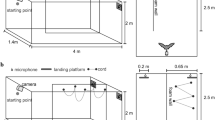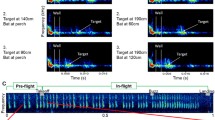Summary
-
1.
The echolocative skills ofPteronotus parnellii parnellii andEptesicus fuscus were studied by measuring their ability in avoiding stationary and moving obstacles.
-
2.
The frequency, repetition rate, duration and amplitude of the orientation signals emitted by the bat during three phases of negotiation of obstacles were studied.
-
3.
During the avoidance of obstacles, both species of bats systematically shorten the duration, increase the repetition rate, and decrease the amplitude of their emitted orientation signals as they approach, negotiate and pass the obstacles.
-
4.
Flying at different speeds inside the flight room during the avoidance of obstacles,Pteronotus parnellii parnellii appropriately adjust their emitted CF frequency according to the flight speed to accurately compensate for the positively Doppler-shifted echoes.
-
5.
The frequency of the FM signals emitted at high repetition rate byEptesicus fuscus shifts downward as the bat enters into the final phase of negotiation of the obstacles.
-
6.
The significance of the change in parameters of emitted signals in relation to echolocation is discussed. Presumably, the increase in the repetition rate of sound emission and the shortening of the sound duration is to monitor rapid changes in obstacle positions. The decrease in sound amplitude is either due to the difficulty in producing loud short sounds at the end of a long-held breath or to appropriately adjust the echo amplitude into the optimal range of sensitivity of the bat's ears.
Similar content being viewed by others
References
Curtis WE (1962) Quantitative studies of echolocation in bats (Myotis l. lucifugus); Studies of vision in bats (Myotis l. lucifugus) and (Eptesicus f. fuscus) and quantitative studies of vision in owls (Tyto alba practincola). Thesis deposited in the library of Cornell Univ, Ithaca, New York
Griffin DR (1958) Listening in the dark. Yale University Press, New Haven, Connecticut. (Reprinted by Dover Publications, New York, 1974)
Griffin DR, McCue JJG, Grinnell AD (1963) Resistance of bats to jamming. J Exp Zool 152:229–250
Griffin DR, Novick A (1955) Acoustic orientation of neotropical bats. J Exp Zool 130:251–300
Griffin DR, Webster FA, Michael CR (1960) The echolocation of flying insects by bats. Anim Behav 8:141–154
Grinnell AD, Griffin DR (1958) The sensitivity of echolocation in bats. Biol Bull 114:10–22
Gustafson Y, Schnitzler H-U (1979) Echolocation and obstacle avoidance in the hipposiderid batAsellia tridens. J Comp Physiol 131:161–167
Harrison JB (1965) Temperature effects on responses in the auditory system of the little brown batMyotis l. lucifugus. Physiol Zool 38:34–48
Henson OW (1970) The ear and audition. In: Wimsatt (ed) Biology of bats. Academic Press, London New York, pp 181–264
Jen PH-S (1982) Echolocation in the bat; obstacle avoidance by the bat and signal coding in the bat's cerebellum. Proc Natl Sci Council (China) 6:71–80
Jen PH-S, McCarty JK (1978) Bats avoid moving objects more successfully than stationary ones. Nature 275:743–744
Jen PH-S, Lee YH, Weider RK (1980a) The avoidance of stationary and moving obstacles by little brown bats,Myotis lucifugus. In: Busnel R-G, Fish JF (eds) Animal sonar systems. Plenum Press, New York, pp 917–919
Jen PH-S, McCarty JK, Lee YH (1980b) The avoidance of obstacles by little brown bats,Myotis lucifugus In: Wilson DE, Gardner AL (eds) Proc 5th Int Bat Res Conf. Texas Technical University Press, Lubbock, Texas, pp 23–28
Konstantinov AI, Sokolov BV, Stosman JMA (1967) Comparative research on bat echolocation sensitivity. DAN SSSR 175:1418
McCarty JK, Jen PH-S Detection of moving and stationary targets by the big brown bat,Eptesicus fuscus. J Comp Physiol (submitted)
Möhres FP, Neuweiler G (1966) Die Ultraschallorientierung der Großblatt-Fledermäuse (Chiroptera-Megadermatidae). Z Vergl Physiol 53:195–227
Neuweiler G, Möhres FP (1967) The role of spacial memory in the orientation. In: Busnel R-G (ed) Animal sonar systems. Lab Physiol Acoust, Jouy-en-Josas, France, pp 129–140
Novick A (1971) Echolocation in bats: some aspects of pulse design. Am Sci 59:198–209
Novick A, Vaisnys JR (1964) Echolocation of flying insects by the bat,Chilonycteris parnellii. Biol Bull 127:478–488
Pollak GD, Bodenhamer RD (1981) Specialized characteristics of single units in inferior colliculus of mustache bat: frequency representation, tuning and discharge patterns. J Neurophysiol 46:605–620
Schneider H, Möhres FP (1960) Die Ohrbewegungen der Hufeisen-Fledermäuse (Chiroptera-Rhinolophidae) und der Mechanismus des Bildhörens. Z Vergl Physiol 44:1–40
Schnitzler H-U (1967) Discrimination of thin wires by flying horseshoe bats (Rhinolophidae). In: Busnel R-G (ed) Animal sonar systems, vol I. Lab Physiol Acoust, Jouy-en-Josas, France, pp 69–87
Schnitzler H-U (1968) Die Ultraschall-Ortungslaute der Hufeisen-Fledermaus (Chiroptera-Rhinolophidae) in verschiedenen Orientierungs-situationen. Z Vergl Physiol 57:376–408
Schnitzler H-U (1970) Echoortung bei der FledermausChilonycteris rubiginosa. Z Vergl Physiol 68:25–38
Schnitzler H-U, Henson OW (1980) Performance of airborne animal sonar systems. I. Microchiroptera. In: Busnel R-G, Fish JF (eds) Animal sonar systems. Plenum Press, New York, pp 109–182
Simmons JA (1981) Detection of range motion in bat sonar. J Acoust Soc Am (Suppl 1) 69:112
Simmons JA, Fenton MB, O'Farrell MJ (1979) Echolocation and pursuit of prey by bats. Science 203:16–21
Suga N, Jen PH-S (1976) Disproportionate tonotopic representation for processing species-specific CF-FM sonar signals in the mustache bat auditory cortex. Science 194:542–544
Suthers RA, Fattu JM (1973) Mechanisms of sound production by echolocating bats. Am Zool 13:1215–1226
Webster FA, Brazier OB (1968) Experimental studies on location mechanisms in bats. Aerospace Medical Res Lab, Wright-Patterson Air Force Base, Ohio, AD 673373
Author information
Authors and Affiliations
Rights and permissions
About this article
Cite this article
Jen, P.H.S., Kamada, T. Analysis of orientation signals emitted by the CF-FM bat,Pteronotus p. parnellii and the FM bat,Eptesicus fuscus during avoidance of moving and stationary obstacles. J. Comp. Physiol. 148, 389–398 (1982). https://doi.org/10.1007/BF00679023
Accepted:
Issue Date:
DOI: https://doi.org/10.1007/BF00679023




